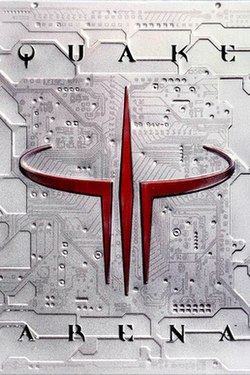Quake III Arena (also known as Quake 3; abbreviated as Q3A or Q3), is a multiplayer first-person shooter computer and video game released on December 2, 1999. The game was developed by id Software and featured music composed by Sonic Mayhem and Front Line Assembly. Quake III Arena is the third in the series and differs from previous games by excluding a traditional single-player element and focusing on multi-player action. The single-player is instead played against computer controlled bots in a similar style to Unreal Tournament.
Notable features of Quake 3 include the minimalist design, lacking rarely used items and features, the extensive customizability of player settings such as field of view, texture detail and enemy model, and advanced movement features such as strafe and rocket-jumping.
Quake 3 is available on a number of platforms and contains mature content. The game was highly praised by reviewers who, for the most part, described the gameplay as fun and engaging. Many liked the crisp graphics and focus on multiplayer.
Quake 3 has also been used extensively in professional electronic sports tournaments such as Quakecon, Cyberathlete Professional League and the Electronic Sports World Cup.
Gameplay
Unlike its predecessors, Q3A does not have a plot-based single-player campaign. Instead, it simulates the multiplayer experience with computer controlled players known as bots. The game's story is brief - 'the greatest warriors of all time fight for the amusement of a race called the Vadrigar in the Arena Eternal.' The introduction video shows the abduction of such a warrior, Sarge, while making a last stand. Continuity with prior games in the Quake series and even Doom is maintained by the inclusion of player models related to those earlier games as well as biographical information included on characters in the manual, a familiar mixture of gothic and technological map architecture and specific equipment; for example, the Quad Damage power-up, the infamous rocket launcher and the BFG super-weapon.
In Quake III Arena the player progresses through tiers of maps, combating different bot characters that increase in difficulty, from Crash (at Tier 0) to Xaero (at Tier 7). As well as tougher opponents the fights take place in more complex arenas as the game progresses. While deathmatch maps are designed for up to 16 players, tournament maps are designed for duels between 2 players and in the single-player game could be considered as 'boss battles'.
The weapons are balanced by role, with each weapon having advantages in certain situations such as at long-range or fired around a corner; the BFG is an exception to this as a super-weapon. Weapons appear as level items, spawning at regular intervals in set locations on the map. If a player dies all their weapons are lost and they receive the spawn weapons for the current map, usually the gauntlet and machine gun. Players also drop the weapon they were using when killed, which other players can then pick up.
Q3A comes with several gameplay modes; Free for All (FFA), a classic deathmatch, where each player competes against the rest for the highest score, Team Deathmatch (TDM), where usually two teams of four compete for the highest team frag total, Tournament (1v1), a deathmatch between two players, usually ending after a set time and Capture the Flag, which is played on symmetrical maps where teams have to recover the enemy flag from the opponents' base while retaining their own.
Quake III Arena was specifically designed for multiplayer, the game allows players whose computers are connected by a network or to the internet, to play against each other in real time. It employs a client–server model, requiring all players' clients to connect to a server. Q3A's focus on multiplayer gameplay spawned a lively community, similar to Quakeworld, that is active to this day.
Development
During early March 1999, ATI leaked the internal hardware vendor (IHV) copy of the game.[4] This was a functional version of the engine with a textured level and working guns. The IHV contained most the weapons (excepting the Gauntlet) that would make it into the final game although most were not fully modeled; a chainsaw and grappling hook were also in the IHV but did not make it into the final release. Many of the sounds that would make it into the final release were also included.
After the IHV fiasco id Software released a beta of the game called Quake III Arena Test on April 24, 1999. The Q3Test started with version 1.05 and included three levels that would be included in the final release: dm7, dm17, and q3tourney2. Id software continued to update Q3Test up until version 1.09.
During the game's testing it was found that the lightning gun was too dominating. Its strength was reduced to the point that some players have found it useless. Weapon balance was achieved by examining earlier games in the series, Quake and Quake II as well as extensive play testing with well-known players such as Thresh. In the first Quake the rocket launcher was so effective that it dominated entire deathmatches while the rocket launcher in Quake II so weak that it was sometimes ignored. The rocket launcher in Quake III is effective but not overpowering, allowing it to be countered in many situations.
skip to main |
skip to sidebar
Blog Artikel Teknologi Informasi (TI), Game, dan Design. Semoga Indonesia semakin maju.
Pages
About Me
- Arie Setiawan
- Arie Setiawan, pekerjaan sebagai Dosen di Fakultas Teknologi Informasi, UKSW - Salatiga. S2: Ilmu Komputer UGM S1: Teknik Elektro UKSW SMA : SMA Lab UKSW
Powered by Blogger.





